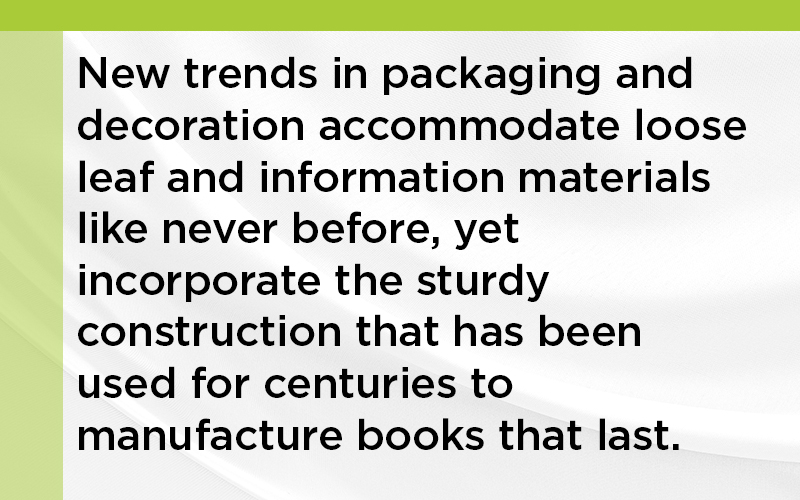
by: Joe Anderson
The information packaging solutions available today are more creative and attractive than ever. New trends in packaging and decoration accommodate loose leaf and information materials like never before, yet incorporate the sturdy construction that has been used for centuries to manufacture books that last. Ring binders in particular often can combine colorful decoration and durable materials to create versatile products that meet your specific project demands.
There are many applications for durable turned-edge ring binders, which perhaps explains why they are so widely used for sales kits, conferences, academic materials, and many other products. Ring binders are an easy solution for combining literature with multi-media, or pocket folders, or product samples, or well, you get the idea. Not only are binders versatile, the decorative options are virtually unlimited. Let’s take a look at the construction and usage options.
The Process
For most turned-edge products, glue is applied to the back of the cover material, which is then wrapped to a board, thus giving this process its name. Like most products, a good foundation is essential for building your binder, making the board one of the binder’s most important components.
Board is available in a range of strengths and thicknesses. Commonly used grades include pasted-chip (chipboard), Graphic board (fordiner board-100% news-short fiber), SBS (paperboard), wet-lap board (spec board), Maxite (micro-flute) and foam padded board.
Different uses require different calipers and construction techniques to ensure the best results. The board type is generally determined by the binder contents, intended usage and environment of the end user. Binders destined for a single-use seminar, for example, will require materials far different than instruction manuals for industrial settings.
Cover Material and Decoration
Not all cover materials are created equally. They vary widely in look, feel, durability and production parameters. Selection often hinges on decorative options, final use, turnaround, and of course, cost. Your finisher can often provide guidance for balancing these requirements and suggest products and options that best suit your needs.
One of the big advantages of turned-edge manufacturing is that almost any material can be used for the wrap. Offset-printed and film-laminated paper is a common choice because it allows for vivid, four-color graphics. For total personalization, paper covers can be digitally printed prior to lamination.
In recent years, stock options have expanded beyond traditional papers. Saturated, unsaturated, craft-based and some fiber reinforced papers are commonly available. Companies such as Fibermark and Ecological Fibers provide earth-friendly paper alternatives, which can be crafted to mimic common stocks while adding a unique dimension to your products.
Additional materials include imitation leather, book cloth and many others. Custom decorations such as diecuts, digital or screen printing, foil stamping, embossing or debossing can give binder products a truly unique look. Combining techniques and materials can often produce handsome products of lasting value, so discuss the possibilities and designs with your finisher.
Lining Material and Binder Interiors
Perhaps the most forgettable part of the binder, the binder interior can be a highly functional design element as well. Lining material is glued to the board on the inside of the binder. Typically, the lining is about 1/8″ short of the edge on all four sides, allowing the cover material to be seen around the edges, “framing” the interior lining.
Combining loose-leaf, wire bound or information brochures with multi-media pieces or collections can be frustrating, but liners can be designed to incorporate PVC trays for CDs or DVDs, customized pockets, cavities cut to suit and even boxes to house specialty items. Again, each finisher has different manufacturing techniques and processes to produce customized products, so consult with a design team early in the planning stages to determine what options are appropriate.
Ring Metals
Without ring metals, the binder does not exist. Nickel plated rings are used most often, but stock and custom painted metals are also available to match designs and color schemes. Several ring styles are available, and though each is meant to hold materials inside the binder, each option provides a different look and functionality. Each of the following are available with locking boosters that hold material securely:
Round rings – The most common ring binder metal, round rings can be mounted to the spine or the back cover with rivets, which can be exposed or concealed.
Straight D rings – This style is similar in operation to round ring metals, but the metal piece itself is shaped like a backwards D, opening where the straight back meets the top of the curve. Straight-D rings are mounted to the back cover of the binder and display loose leaf contents evenly along the index edge.
Angle D rings – This style is also mounted to the back cover, but the angled design allows the rings to hold up to 30 percent more loose leaf material than standard round ring metals of the same capacity. This additional capacity makes angle D-ring metals ideal for high-capacity applications. Another advantage: angle-D rings taper top-to-bottom along the index edge, allowing for easier viewing of contents.
Important note: never ship your literature on the ring itself. The stresses in transit can damage the tension bars and destroy ring functionality. Always package your materials inside the binder but off of the ring. This is the best way to ensure your product arrives undamaged.
Regardless of format, information packaging and display materials are designed to attract attention and withstand substantial use. Most finishers can help you design a completely customized turned-edge loose leaf binder that meets both aesthetic and budgetary needs. And remember, effectively planned production leads to high quality products, which is always eye-catching.
Joe Anderson heads the information packaging division of Eckhart & Company, an Indianapolis, Ind.-based bindery specializing in mechanical binding, loose leaf manufacturing, and information packaging. Anderson can be reached at (800) 443-3791 or joeanderson@eckhartandco.com.

